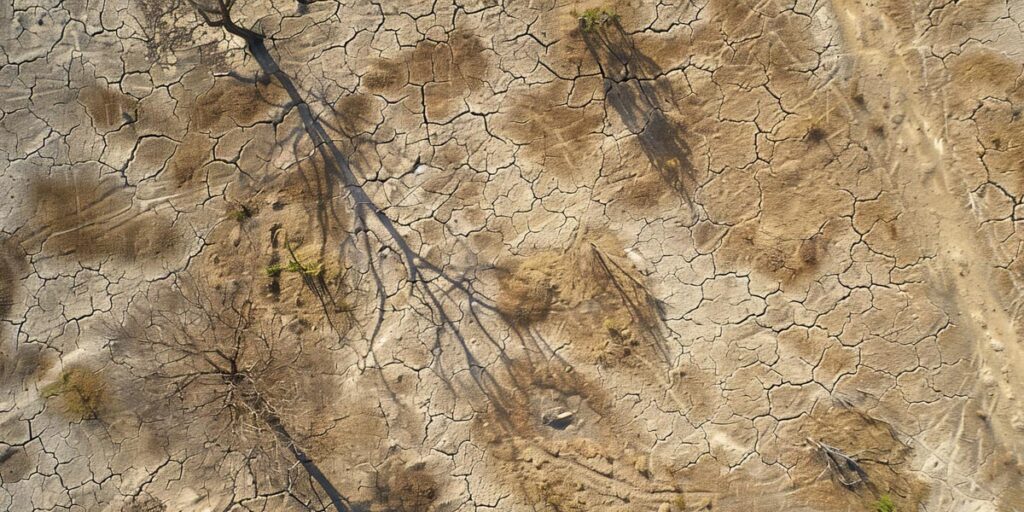As we mark World Environment Day 2024, we are reminded of the profound importance of our planet’s land. This year’s theme, “Land Restoration, Desertification and Drought Resilience”, highlights the urgent need to address the mounting land degradation crisis. With the global population surpassing 8.1 billion, the pressure on our natural resources is immense, making sustainable land management more crucial than ever.
Land, with its defining elements of soils, vegetation, and inland water resources, is threatened worldwide by numerous degradation processes. These processes may drive the decrease or collapse of biological and economic productivity, biodiversity, ecological integrity, or ecosystem function that support the delivery of primary ecosystem services. The negative land degradation has profound implications for agricultural productivity, food security, climate stability, environmental sustainability and economic prosperity. The global economic impact of land degradation, assessed through the loss of various ecosystem services, is estimated to total between $6.3 trillion and $10.6 trillion annually.
Between 2015 and 2019, the planet lost at least 1 million sq km of fertile land annually – twice the size of Greenland. These alarming figures underscore the urgent action.
Land degradation effects on human well-being
Worsening land degradation affects 3.2 billion people worldwide, undermining the well-being of two-fifths of humanity, causing species extinction, and intensifying climate change. It also significantly contributes to mass human migration and increased conflict. According to the Intergovernmental Science-policy Platform on Biodiversity and Ecosystem Services (IPBES), the comprehensive, evidence-based assessment reveals the critical dangers of land degradation.
| Economic cost 2010 | 10 % of the world’s annual gross products |
| Natural ecosystems converted to croplands ( 2014) | Over 15 million sq. km |
| Land surface impacted by human activity | >75% |
| Projected impact by 2050 | <10% of the land will escape significant human impact |
Audrey Azoulay, UNESCO director-general, emphasised the need to address the issue, “This report demonstrates the challenges we face due to global soil degradation and the impact on human life if this critical issue is not urgently addressed”.
Major drivers and manifestations of land degradation
Rapid expansion and unsustainable management of croplands and grazing lands are the most extensive global drivers, causing significant loss of biodiversity and ecosystem services.
High consumption in developed economies and rising consumption in developing economies increase land degradation.
Agriculture expansion, natural resources extraction and urbanisation: More land is cleared for farming to meet the rising demand for food and biofuel, often at the expense of forests and other natural resources. Mining, logging, and drilling require large land areas, causing soil erosion and habitat loss. Growing cities need more land for housing and infrastructure, encroaching on agricultural land and natural areas, contributing to land degradation.
By the numbers
Recent stats paint a dire picture. The statistics highlight trends in agriculture and its environmental impact. Only 1% of farms control most of the agricultural land, while 80% of all farms are smaller than 2 hectares. These large farms receive a substantial portion of the $700 billion paid annually in agricultural subsidies. However, only about 15% of these subsidies positively impact natural capital or biodiversity.
The food sector is a significant driver of deforestation and freshwater use. A major part of the forest clearing for agriculture between 2013-19 violated national laws. The food system is responsible for 80% of deforestation and 70% of freshwater use. If current trends continue, this will threaten land productivity, particularly in sub-Saharan Africa, where there will be a long-term decline in land yield. Urgent Action is required to address these unsustainable practices..
| Statistics | Figures |
| Farm controlling agricultural land | 1 % of farms control 70% of agricultural land |
| Annual agriculture subsidy | $700 billion, with only 15% showing a positive impact on natural resources and biodiversity |
| Forest clearance | 70% of the forest was cleared between 2013 and 2019, in violation of national laws |
| Food sector responsibility | 80% of deforestation and 70% of freshwater use |
| Projected additional land degraded by 2050 | 16 million sq. km |
| Threat to productivity (agricultural and natural lands) | 12-14 % decline, particularly affecting sub-Saharan Africa |
The Global Crisis of Land degradation

Approximately 40% of the Earth’s surface faces degradation, impacting half the global population and negatively impacting nearly half of the world’s GDP. Persisting with current practices could accelerate this crisis, leading to further degradation equal to almost all of South America. Despite this, restoring 10 million sq. km. of degraded land by 2030 requires a modest investment of $1.6 trillion this decade.
To put into perspective, this $1.6 trillion investment over 10 years is less than $700 billion spent annually on fossil fuels and agricultural subsidies. This funding is aimed at critical environmental issues and is necessary for promoting global ecosystems, food security and climate resilience. As climate shifts escalate and food prices soar, immediate action towards conservation, restoration, and sustainable land management is essential to avert a looming crisis.
County-wise Differences in Land degradation
The United Nations Convention to Combat Desertification (UNCCD) Data Dashboard presents a reality check, highlighting significant variations in the extent of land degradation worldwide.
| Region | Land Degradation Impact |
| Eastern and Central Asia | Severe degradation impacting over 20% of total land area |
| Latin America and the Caribbean | Severe degradation impacting over 20% of total land area |
| Sub-Saharan Africa | Land degradation rates surpass the global average |
| Western and Southern Asia | Land degradation rates surpass the global average |
| Total land lost since 2015 | Sub-Saharan Africa: 1,630,000 sq. km; Latin America and the Caribbean: 1,080,000 sq. km |
Desertification
Every year, 100,000 sq. km of land turns into desert. The UN has highlighted desertification as one of the greatest environmental challenges of our time. The world’s deserts are expanding at an alarming rate.
Another silent killer of lands is drought, which swallows vast areas of fertile soil and renders them useless for agriculture, often in regions where people already face hunger. By 2025, 1.8 billion people will experience absolute water scarcity; by 2045, 135 million people could be displaced due to desertification. Over 75% of the Earth’s land area is already degraded, and that number could be over 90% by 2050.
If current land and natural resource degradation trends continue, and the demand for food, feed, fibre and bioenergy rises, the consequences could be dire. By 2050, an additional 16 million sq. km could face continued land degradation. A persistent long-term decline in vegetative productivity is projected for 12-14% of agricultural, pasture and grazing lands, and natural areas in sub-Saharan Africa to be worst affected. An additional 69 gigatonnes of carbon would be emitted by 2050 due to land use change and soil degradation, representing 17% of current annual greenhouse gas emissions.
Reversing Land Degradation: Benefits and Potential

According to the U.N.’s Global Land Outlook 2 report from the United Nations Convention to Combat Desertification (UNCCD), reversing land degradation can alleviate the effects of climate change, biodiversity loss, and food insecurity – addressing 3 major environmental challenges in a single stroke.
The report points out that 40% of the Earth’s land has been compromised by development, deforestation, farming, and other human activities. However, it also offers a vision of benefits that could accrue by 2050 if humanity acts to restore landscapes and reverse this toll.
The Benefits of Land Restoration
| Benefits | Projections |
| Crop Yields | Increase by 5% to 10 % in developing countries in the Middle East, Africa and Latin America |
| Carbon Storage | The land will store 17 gigatons more carbon over 35 years. |
| Biodiversity | Decline more slowly, with 11% of expected extinctions avoided |
| Natural Areas | Global loss of natural areas will slow |
The report paints an even more optimistic scenario if nations could, in addition to restoring 50 million sq. km of land, protect areas equal to half of Earth’s land surface that are important for preserving biodiversity, maintaining water flows, and providing other benefits. Meeting that goal would require increasing crop yield by at least 9%, but the result could include:
| Projected Outcomes by 2050 | Expected Benefits |
| Natural Area Expansion | 4 million sq. km |
| Biodiversity Decline | One-third of expected extinctions avoided |
| Carbon Trapping | 83 gigatons of carbon, equivalent to 7 years of current global emissions, aiding in limiting global warming to 1.5°C |
Great Green Wall
The Great Green Wall initiative launched in 2007 aims to restore degraded drylands across Africa from Senegal to Djibouti, significantly contributing to healthier ecosystems post-COVID-19. Originally focussed on tree planting, the initiative has evolved to include sustainable land use, livelihood creation and peacebuilding.
Objectives & Achievements
- Address landscape degradation escalated by climate change and population growth, fostering sustainable development and conflict resolution
- Spans 7.8 million sq. km, twice the size of India, with commitments to restore 1 million sq. km by 2030, aligning with 10 SDGs and endorsed by over 20 countries
- It is supported by international organisations like FAO and UNEP, which are planning to enhance the initiative and emphasise its role in the UN Decade on Ecosystem Restoration 2021–2030.
Call to action
Land restoration is crucial for ensuring water and food security, reducing disaster risks, improving public health and advancing Sustainable Development Goals. To achieve a land degradation-neutral world by 2030, we must restore 15 million sq. km of degraded land. This World Environment Day, let’s act decisively. Join #GenerationRestoration, and together, let us protect and nurture our land for the well-being of present and future generations.
Sources
World Environment Day 2024 (unep.org)
unep.org
A third of the world’s land surface is threatened by desertification
At least 100 million hectares of healthy land now lost each year
Land Degradation
Nature loss: Insatiable greed degrading land around the world – UN
Chronic land degradation: UN offers stark warnings and practical remedies in Global Land Outlook 2
Worsening land degradation impacts 3.2 billion people worldwide
Media Release: Worsening Worldwide Land Degradation Now ‘Critical’, Undermining Well-Being of 3.2 Billion People | IPBES secretariat
Global land degradation serious, U.N. report finds, but restoration offers hope
See Also:


